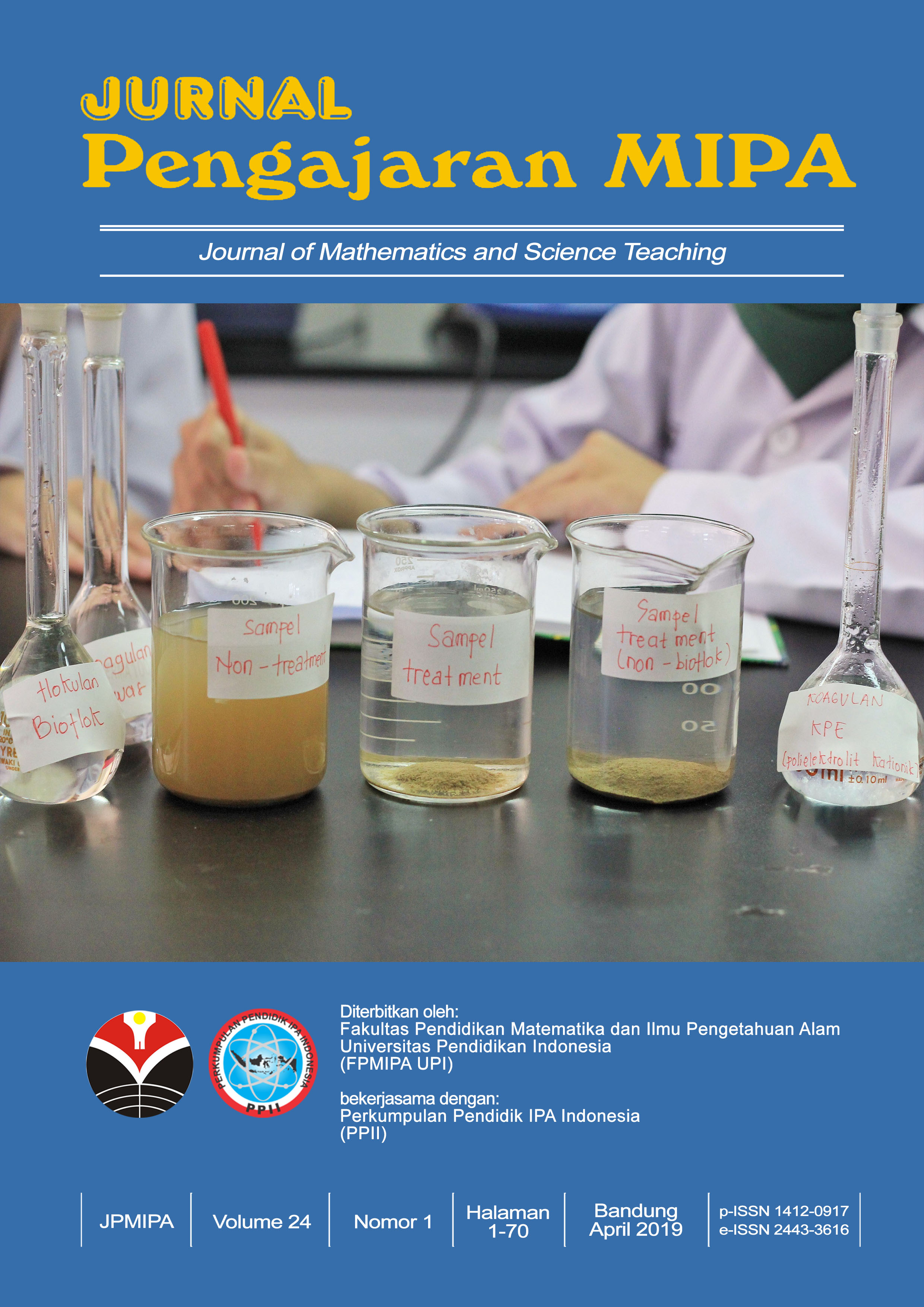HIGH SCHOOL STUDENTS’ LEARNING OBSTACLES IN UNDERSTANDING FRACTIONAL EXPONENTS AND ROOT FORMS
Abstract
Keywords
References
Behr, M. J., Lesh, R., Post, T., & Silver, E. A. (1983). Rational number concepts. Acquisition of mathematics concepts and processes, 91-126.
Birenbaum, M., & Tatsuoka, K. K. (1993). Applying an IRT-based cognitive diagnostic model to diagnose students' knowledge states in multiplication and division with exponents. Applied measurement in education, 6(4), 255-268.
Brousseau, G. (2002). Theory of didactical situations in mathematics.New York: Kluwer Academic Publisher.
Ernest, P. (1985). The number line as a teaching aid.Educational Studies in Mathematics, 16(4), 411-424.
Gagatsis, A., Shiakalli, M., & Panaoura, A. (2003). La droite arithmétique comme modèle géométrique de l’addition et de la soustraction des nombres entiers. In Annales de didactique et de sciences cognitives (Vol. 8, pp. 95-112).
Hewson, A. E. (2013). An examination of high school students' misconceptions about methods of exponential equations (Doctoral dissertation).
Krátká,M.(2007).Horizon as epistemological obstacle to understanding infinity. WORKING GROUP 7. Geometrical Thinking 954, 1002.[Online].Diakses darihttp://www. mathematik. uni-dortmund.de-/-rme/CERME5b/ WG7pdf.
Lesh, R., Post, T., & Behr, M. (1987). Representations and translations among representations in mathematics learning and problem solving.Problems of representation in the teaching and learning of mathematics, 21, 33-40.
Michaelidou, E., & Gagatsis, A. (2003). The use of the geometrical model of number linefor representing equivalence and addition of fractions concerning fifth grade students: Aresearch proposal. In A. Gagatsis (Ed.), Representations and geometrical models inmathematics learning (in greek) (pp. 71-98).
Michaelidou, N., Gagatsis, A., & Pitta-Pantazi, D. (2004). The Number Line as a Representation of Decimal Numbers: A Research with Sixth Grade Students. International Group for the Psychology Of Mathematics Education.
Pinahayu, E. A. R. (2016). Problematika Pembelajaran Matematika Pada Pokok Bahasan Eksponen Dan Alternatif Pemecahannya. Formatif: Jurnal Ilmiah Pendidikan MIPA, 5(3).
Pitta-Pantazi, D., Christou, C., & Zachariades, T. (2007). Secondary school students’ levels of understanding in computing exponents. The Journal of Mathematical Behavior, 26(4), 301-311.
Raftopoulos, A. T. H. A. N. A. S. S. I. O. S. (2002). The spatial intuition of number and the number line. Mediterranean Journal for Research in Mathematics Education, 1(2), 17-36.
Ramazan, A. (2010). Eight graders’ capabilities in exponents: making mental comparisons. practice and theory in systems of education. Volume 5 Number 1 2010.Aksaray University, Aksaray, Turkey.
Reys, R. E., & Yang, D. C. (1998).Relationship between computational performance and number sense among sixth-and eighth-grade students in Taiwan.Journal for Research in Mathematics Education, 225-237.
Rosita, Uliyanti E., & Buwono, S. (2013). Peningkatan Aktivitas Belajar melalui Metode Latihan Pelajaran Matematika Kelas II SDN 42 Kubu Raya.Tersedia: http://jurnal. ntan.ac.id/index.php/jpdpb/article/viewFile/498/pdf. [28 Februari 2015].
Suherman, E. (2003). Strategi pembelajaran matematika kontemporer.Bandung: Universitas Pendidikan Indonesia.
Suratno, T. (2009). Memahami kompleksitas pengajaran-pembelajaran dan kondisi pendidikan dan pekerjaan guru. Tersedia: http://the2the. com/eunica/document/TSuratno_complex_syndrome. pdf [18 Mei 2013].
Tall, D., & Vinner, S. (1981). Concept image and concept definition in mathematics with particular reference to limits and continuity. Educational studies in mathematics, 12(2), 151-169.
Tseng,D. (2012). Conceptual and procedural knowledge in mathematics education-in the case of law of exponents.Polygon Spring.
Vinner, Shlomo."Concept definition, concept image and the notion of function."International Journal of Mathematical Education in Science and Technology 14, no. 3 (1983): 293-305.
Wahyuni, W., Anggraini, A., & Rochaminah, S. (2016). Penerapan Metode Latihan untuk Meningkatkan Hasil Belajar Siswa pada Materi Limit Fungsi di Kelas XI IPA SMA Alkhairat Kalukubula.Jurnal Elektronik Pendidikan Matematika Tadulako, 3(3).
DOI: https://doi.org/10.18269/jpmipa.v23i1.16937
Refbacks
- There are currently no refbacks.
Copyright (c) 2019 Jurnal Pengajaran MIPA

This work is licensed under a Creative Commons Attribution-ShareAlike 4.0 International License.
JPMIPA http://ejournal.upi.edu/index.php/jpmipa/index is licensed under a Creative Commons Attribution-ShareAlike 4.0 International License
Jurnal Pengajaran Matematika dan Ilmu Pengetahuan Alam (JPMIPA) or Journal of Mathematics and Science Teaching
All rights reserverd. pISSN 1412-0917 eISSN 2443-3616
Copyright © Faculty of Mathematics and Science Education (FPMIPA) Universitas Pendidikan Indonesia (UPI)
View JPMIPA Stats









